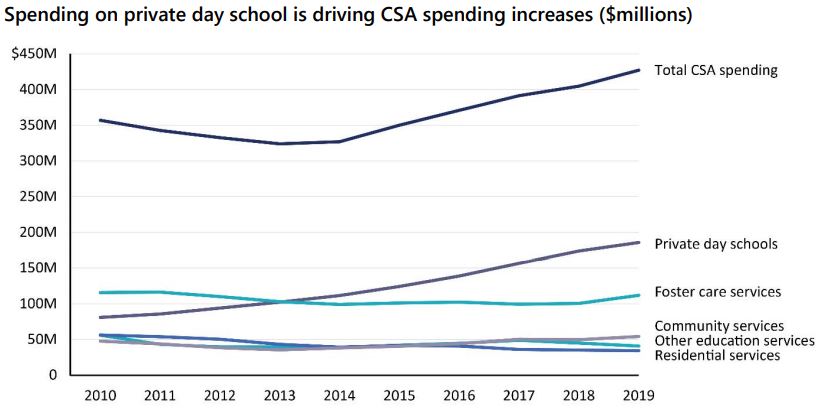
by James A. Bacon
More than 17,000 Virginia school children were categorized by the Virginia Department of Education as being disabled by autism or severe emotional issues in the 2018-19 school year. If these students get too unruly for schools to handle, they often wind up getting transferred to private special-education day schools.
The cost of providing these special services, paid under the state’s Children’s Services Act (CSA), has more than doubled since Fiscal Year 2010 to $186 million, according to a new report by the Joint Legislative Audit and Review Commission (JLARC). Spending increases have averaged about 14% per year since FY 2010.
Tuition at these private schools range from $22,000 to $97,000 per child, consistent with the cost of providing low student-to-staff ratios. Charges per child have risen about 3% annually, a bit more than the inflation rate. The big cost driver has been the 50% increase in enrollment over the decade.
Private day schools have grown into a significant educational expense in Virginia. Continued spending growth could crowd out funding for other priorities. Total spending by the Children’s Services Act of more than $400 million covers foster care, community services and other programs, all of which have been flat or declining over the decade.
The underlying problem is the increase in increasingly “challenging” — e.g. violent and disruptive — behavior of school children. Writes JLARC:
According to especial education directors across the state, the types of challenging behaviors that often result in private day school placement are usually associated with underlying trauma, autism, or some other childhood mental disorder. … Of children who received an initial assessment for CSA services … the percentage of children who reported experiencing trauma grew by 20 percent between FY10 and FY19.
The prevalence of autism and other childhood mental disorders has also increased in the same time period. According to the Centers for Disease Control and Prevention (CDC), the prevalence of autism increase by over 60 percent between 2008 and 2016, from one in 88 children to one in 54 children. Virginia’s special education data shows an even more dramatic increase in the prevalence of autism in a similar timeframe. Virginia students identified with autism increased by 124 percent between 2009 and 2019.
JLARC approaches CSA funding primarily as a fiscal and administrative issue. The study’s top recommendations are to put the program under the control of the Virginia Department of Education and to allow funds to flow to public schools if they can use the money to prevent children from being placed in more restrictive — and expensive — private settings.
But JLARC framed its questions in such a way as to ignore a critical question: Why has there been such a dramatic increase in the number of children experiencing early trauma? Could the Commonwealth of Virginia allocate its limited dollars to reduce the incidence of childhood trauma in the first place? To be more specific, could the state reduce the incidence of childhood trauma by investing in a superior foster care system?
Foster care spending was flat over the 10-year period studied. Adjusted for inflation, it actually declined. The quality of foster care programs in Virginia is notoriously spotty. How many children subjected to abuse and neglect could be saved by a better-run system?
Virginia seems to be caught in a vicious cycle in which declining resources for foster care increases the incidence of neglect, abuse, and childhood trauma… which manifests itself in more children conducting disruptive emotional outbursts in public schools… which leads to more problem children being placed in expensive private day care settings…. which takes away money that might otherwise have been allocated to foster care.
Admittedly, one can’t blame foster-care under-funding for the increase in autism, so the problem is likely more complex than I have described here. Still, we seem caught on a treadmill, and it would be helpful to take a more holistic view than JLARC has adopted for this study.

Leave a Reply
You must be logged in to post a comment.